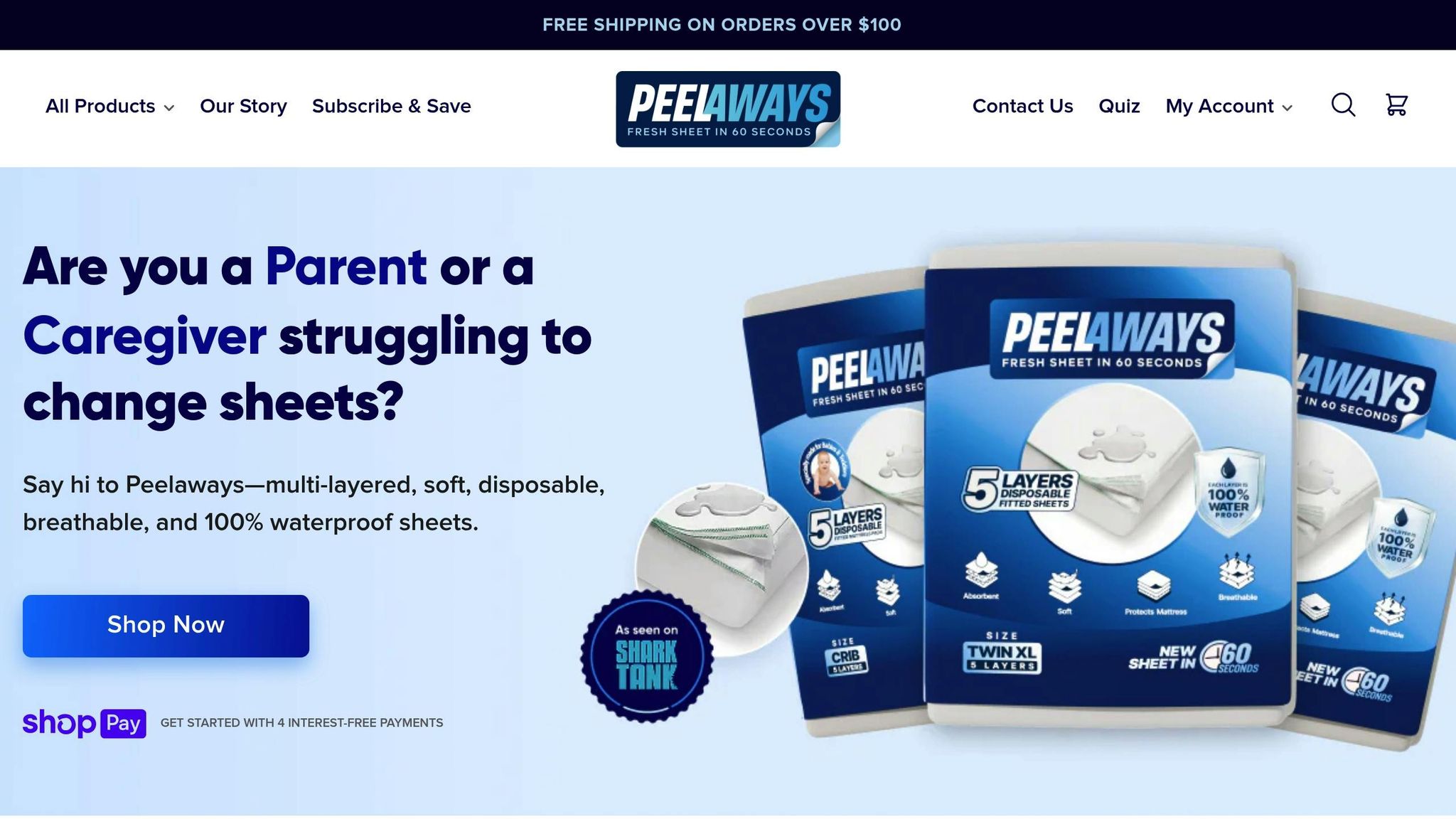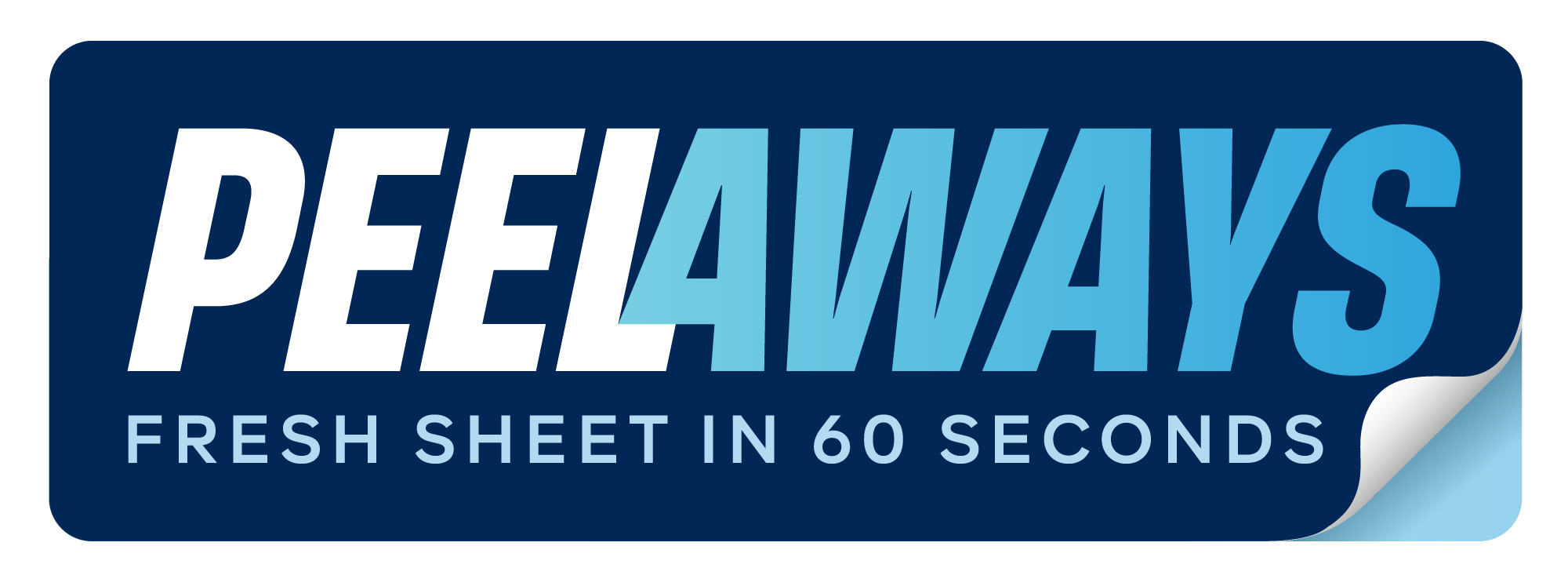Solutions for Nighttime Accidents in Autism Care

Nighttime accidents are a common challenge for caregivers of individuals with autism, affecting up to 40% of children in this group. These incidents disrupt sleep, create physical and emotional stress for families, and can lead to hygiene issues if not managed effectively. Factors like sensory sensitivities, developmental delays, deep sleep patterns, and medical conditions often contribute to these accidents.
Quick solutions, such as multi-layer disposable bedding like PeelAways, offer practical ways to manage these incidents. These sheets allow caregivers to peel away soiled layers in seconds, reducing cleanup time and stress. They’re waterproof, soft, and free from harsh chemicals, making them comfortable and safe for individuals with autism. Combining these tools with consistent routines and preparation can make nighttime care less stressful for everyone.
Key takeaways:
- Challenges: Sensory issues, developmental delays, deep sleep, and medical conditions.
- Impact: Sleep disruption, emotional toll, hygiene concerns, and caregiver burnout.
- Solution: Multi-layer disposable bedding (e.g., PeelAways) simplifies cleanup, promotes hygiene, and ensures comfort.
Caregivers can reduce stress and improve sleep quality by using practical tools and strategies tailored to the unique needs of individuals with autism.
Bed Wetting Solutions: 5 Steps Every Parent Should Know
Problems with Managing Nighttime Incontinence
Dealing with nighttime incontinence in autism care brings a whole set of challenges that go beyond the usual bedwetting scenarios. These difficulties often place a heavy burden on both caregivers and those they care for. Traditional solutions frequently miss the mark, as they fail to address the specific needs of individuals with autism. Understanding these challenges highlights why standard approaches often fall short and underscores the need for better alternatives.
Time and Effort Involved in Bedding Changes
Traditional bedding can turn into a massive time sink when accidents occur, especially if they happen multiple times in a single night. Each bedding change can take 15–30 minutes, requiring caregivers to strip the bed, clean up, and replace linens - often in the middle of the night and in near darkness to avoid fully waking the individual[4].
For caregivers supporting individuals with mobility issues, the process becomes even more taxing. Lifting and handling heavy, wet bedding can be physically exhausting. Add to that the constant cycle of washing and drying soiled linens, and the workload quickly becomes overwhelming.
The frequency and unpredictability of accidents compound the issue. Unlike occasional bedwetting, individuals with autism may experience accidents several times a night, requiring repeated bedding changes. This results in sleep deprivation for caregivers, who must stay alert and ready to respond at any moment[4].
Standard mattress protectors often fail under these conditions. They struggle to contain larger accidents, leaving mattresses soaked and requiring extensive cleaning. Scrubbing, sanitizing, and waiting for items to dry can stretch the disruption well into the next day. Beyond the time commitment, these repetitive tasks pose serious hygiene concerns.
Hygiene and Skin Health Concerns
Prolonged exposure to moisture can lead to skin irritation, rashes, and even infections like urinary tract infections or pressure sores[1]. For individuals with autism, who might not be able to express their discomfort, these issues can go unnoticed until they escalate into more serious problems.
Traditional bedding solutions often fall short in maintaining hygiene. Many standard sheets and waterproof protectors allow moisture to seep through, creating an environment where bacteria can thrive. Because changing conventional bedding takes time, individuals may remain in contact with wet materials longer than they should, increasing the risk of skin breakdown and infection.
Frequent accidents make maintaining hygiene even more challenging. For individuals with autism, sensory sensitivities can make the cleaning process uncomfortable or distressing, adding another layer of difficulty[1]. Wet bedding, lingering odors, and the need for frequent skin cleaning create a complex situation requiring both immediate action and a gentle approach.
Cross-contamination is another major concern. Handling soiled linens and cleaning wet mattresses can spread bacteria, posing additional health risks. Even after extensive washing, traditional bedding may not always be completely sanitized, especially when dealing with large volumes of liquid that seep into hard-to-clean areas.
The Importance of Sensory-Friendly Solutions
On top of time and hygiene challenges, the sensory aspects of bedding materials can further complicate care. Many traditional waterproof materials are made from plastic, which creates crinkly noises that can be overwhelming for individuals with auditory sensitivities. These materials also trap heat and moisture, making the sleeping environment uncomfortable.
The texture of conventional waterproof protectors can also be an issue. Some feel sticky, rough, or unnaturally smooth, which can trigger sensory aversions and make it difficult for individuals to fall asleep. Sensory-friendly bedding is essential to minimize discomfort and prevent sleep disturbances, as poor sleep can lead to behavioral and health challenges[1].
Temperature regulation is another hurdle. Plastic-based protectors don't allow airflow, causing overheating and sweating that can lead to sensory discomfort and further disrupt sleep. Ironically, the very solutions designed to manage accidents can end up making sleep problems worse.
Even the process of changing traditional bedding can be overwhelming from a sensory perspective. The crinkling sound of plastic, the cold feel of wet materials, and the disruption of familiar textures and scents can cause significant distress. For individuals with autism who may not wake up after accidents, it's crucial that bedding remains comfortable throughout the night without requiring immediate changes[2].
Consistency is another often-overlooked need. Frequent bedding changes introduce new textures, detergent scents, and wear-and-tear on materials, all of which can heighten anxiety and resistance to bedtime routines. This inconsistency makes managing nighttime care even more challenging for caregivers and individuals alike.
Practical Solutions for Nighttime Accidents
Handling nighttime incontinence doesn’t have to feel overwhelming. By combining smart bedding choices with thoughtful caregiving strategies, you can reduce disruptions, maintain hygiene, and ensure comfort - especially for individuals with autism who may be more sensitive to changes in their environment.
Waterproof and Disposable Bedding: A Game-Changer
Waterproof disposable bedding can significantly cut down on cleanup time and stress. These options eliminate the need for late-night laundry and help maintain hygiene while being soft and gentle on the skin.
One of the biggest perks? You can replace soiled bedding instantly - no stripping the bed or waiting for clean sheets. This quick solution is especially helpful for individuals with autism, as lengthy disruptions to their sleep setup can lead to distress.
Products like PeelAways take this concept to the next level.
PeelAways: The Multi-Layer Bedding Solution

PeelAways are designed with a unique multi-layer peel-away system, allowing caregivers to remove only the soiled layer in less than a minute. Each sheet comes with 5 to 7 absorbent layers, depending on the size, so you’ll always have a fresh, clean surface ready to go - no mattress lifting or immediate laundry required. This feature also helps prevent cross-contamination.
For individuals with sensory sensitivities, PeelAways maintain a consistent texture and feel across layers. Each layer is 100% waterproof, ensuring no liquid seeps through to the mattress or other layers. The sheets also feature a breathable membrane that blocks liquids while allowing airflow, keeping the surface cool and dry.
And here’s the kicker: PeelAways are free from vinyl, PVC, phthalates, and harsh chemicals, making them safe, odorless, and noiseless. Despite their functionality, users often say they feel just like regular sheets.
"These have saved my sanity! With 2 incontinent special needs teenagers... these have relieved a lot of stress. They hold a LOT of liquid and are easy to use and tear away. No more 15 loads of laundry and wet mattresses!" - Jalene Stanger
PeelAways are available in various sizes, from Crib-A-Peel for toddlers at $30.99 to King size at $53.99. Cot and Twin XL sizes come with 7 layers, while standard sizes include 5 layers, offering options for every age and bed size.
Tips for Caregivers
While advanced bedding solutions like PeelAways are incredibly helpful, pairing them with effective caregiving strategies can make nighttime accidents even easier to manage. Here are some practical tips to streamline the process:
- Set Up Properly: Use PeelAways as a fitted sheet, securing it with a regular sheet or straps if needed.
- Be Prepared: Keep extra PeelAways sheets, clean pajamas, and gentle skin wipes close by to avoid scrambling during an accident.
- Stick to a Routine: Practice peeling away soiled layers and disposing of them efficiently. Replace layers every 7–10 days or sooner if soiled to maintain hygiene.
- Add Extra Protection: Consider placing a waterproof mattress protector underneath for added security.
- Create a Calm Atmosphere: Use soft lighting, speak in soothing tones, and work quickly but gently to help the individual return to sleep without added stress.
- Track Patterns: If accidents are frequent, note the timing and any potential triggers. This can help adjust routines or strategies to minimize incidents.
With 79% of families reporting success using consistent bedtime routines to manage bedwetting[3], combining these strategies with practical tools like PeelAways can make nighttime accidents far less daunting.
sbb-itb-45288fe
Benefits of Multi-Layer Disposable Bedding
Multi-layer disposable bedding, like PeelAways, offers practical advantages that go far beyond convenience. These products simplify caregiving during nighttime accidents while creating a more comfortable and hygienic environment, especially for individuals with autism.
Easy to Use and Time-Saving
One of the standout benefits of multi-layer bedding is how it streamlines the process of managing nighttime accidents. PeelAways’ patented design allows caregivers to change a soiled sheet in under a minute - no need to strip the entire bed. All it takes is peeling away the top layer to reveal a clean, fresh sheet underneath.
This time-saving feature is invaluable during late-night emergencies when quick cleanup is essential to get everyone back to sleep. Each layer is completely waterproof, ensuring that liquids don’t seep through to the mattress or the layers below. This eliminates the need for extensive cleanup, like washing the mattress, and drastically cuts down on laundry. The used layers are simply discarded, saving hours otherwise spent washing, drying, and folding bedding.
Jalene Stanger, a caregiver for two special needs teenagers, shared her experience:
"These have saved my sanity! With 2 incontinent special needs teenagers... these have relieved a lot of stress. They hold a LOT of liquid and are easy to use and tear away. No more 15 loads of laundry and wet mattresses!"
Another user, Kalahiki Jr Samuel, highlighted the convenience:
"It is more convenient to use than sheets, less washing, just peel off soiled layer and throw out."
Improved Hygiene and Reduced Cross-Contamination
Quickly replacing soiled bedding not only saves time but also promotes a cleaner and healthier sleeping environment. Each disposable layer provides a fresh surface, helping to reduce bacterial growth, odors, and the risk of cross-contamination. Unlike traditional fabric sheets that require thorough washing to remove pathogens, PeelAways ensure contaminants are completely removed with each discarded layer.
For individuals with sensitive skin or those prone to irritation, this approach helps maintain a dry, clean bed, reducing the likelihood of skin issues. The elimination of cross-contamination is particularly beneficial, as bacteria, allergens, and other irritants are discarded along with the used layer, instead of lingering in fabric fibers.
Comfort and Better Sleep Quality
Despite their disposable nature, PeelAways are designed to feel as comfortable as traditional sheets. Made from a special blend of fibers, they are soft and noiseless, providing a restful sleep experience without compromising on comfort. Many users report that they can’t tell the difference between these sheets and regular bedding.
The breathable membrane base not only blocks liquids but also allows air to circulate, keeping the bed cool and dry throughout the night. This feature is especially important for individuals with autism, who may be sensitive to temperature fluctuations or uncomfortable sleeping conditions.
Safety and sensory needs are also carefully considered in the design. PeelAways are free from vinyl, PVC, phthalates, and fire retardants, making them odorless and safe for those with heightened sensitivities. This chemical-free composition ensures a sensory-friendly environment, which can be critical for individuals with autism who may be particularly sensitive to textures or smells.
By combining quick cleanup with consistent comfort, PeelAways help minimize sleep disruptions for both caregivers and individuals. A dry, comfortable bed throughout the night supports uninterrupted sleep, which is essential for mood, behavior, and overall daytime functioning - key considerations in autism care.
With over 8,000 satisfied customers and a 4.8-star average rating, these multi-layer sheets are praised for their practicality and comfort, proving that functionality and quality sleep can go hand in hand.
Conclusion: Making Nighttime Care Easier
Managing nighttime accidents doesn’t have to disrupt sleep or pile on stress. By sticking to consistent routines and creating a sensory-friendly environment, families can make nights much smoother. A big part of this is having the right bedding system - something that simplifies cleanup while maintaining comfort.
This is where multi-layer disposable bedding systems like PeelAways come in. These systems make cleanup quick and easy, help maintain hygiene, and ensure the sleep environment stays consistent. The soft, breathable, and quiet materials are designed to provide the kind of sensory comfort that individuals with autism often need.
Caregivers have shared how these bedding solutions significantly ease their stress. The chemical-free and sensory-friendly design removes additional challenges, making it easier for everyone to get the rest they need. For individuals with autism, this kind of thoughtful design can preserve dignity and even promote independence, while reducing the embarrassment that accidents might cause.
At first glance, bedding might seem like a small detail. But for families managing autism care, it can be the difference between exhausting, chaotic nights and peaceful, restorative sleep. By reducing stress and simplifying cleanup, these solutions help create a nighttime environment where everyone can thrive.
FAQs
How can multi-layer disposable bedding like Peelaways enhance hygiene and comfort for individuals with autism?
Multi-layer disposable bedding, like Peelaways, offers a smart solution for maintaining hygiene and comfort. Designed with a 100% waterproof and absorbent barrier, it shields mattresses from spills and nighttime mishaps. What sets it apart is its peel-away design - simply remove the used top layer to instantly reveal a fresh, clean sheet underneath. No need for heavy mattress lifting or constant laundry.
Made from soft, quiet materials, it provides a restful sleeping experience. Plus, the disposable layers help reduce the risk of cross-contamination, making it an easy and effective choice for caregivers and families involved in autism care.
What sensory-friendly features do Peelaways sheets offer for individuals with autism, and how do these features support better sleep?
Peelaways sheets are crafted with features that prioritize comfort and cater to sensory needs, making them a great option for individuals with autism. The material is soft and noiseless, creating a tranquil and soothing sleep environment without compromising the natural feel of the mattress.
The sheets also include a breathable base layer that promotes airflow, helping to regulate temperature and keep the bed cool and dry all night long. These details work together to provide a calming and hygienic sleeping experience, especially suited for those with sensory sensitivities.
How can Peelaways help reduce caregiver stress and make nighttime care easier?
Peelaways offer a practical solution to make nighttime care less overwhelming by streamlining bed changes and cutting down on laundry. These sheets feature a multi-layer, disposable design, allowing caregivers to simply peel off a soiled layer to reveal a fresh one underneath. No need to wrestle with heavy mattresses or deal with piles of bedding - saving time, energy, and reducing caregiver stress.
Here’s how to use Peelaways:
- Position the sheet on the mattress, ensuring the colored stitching aligns with the head of the bed.
- Peel off the top layer when it becomes soiled or after 7–10 days for a quick refresh.
- Dispose of the removed layer properly, leaving a clean, hygienic surface ready for use.
Adding Peelaways to your care routine can help simplify the process and make nighttime care more manageable.
Related Blog Posts
- 7 Essential Tips for Nighttime Incontinence Care
- Quick Guide: Managing Overnight Accidents in Children
- How to Keep Beds Dry During Incontinence Care
- Ultimate Guide to Bedwetting Hygiene
Comments
0

SAVE MONEY & WATER
Professionals & Institutions save a fortune on labor/laundry.

SUPERIOR COMFORT
The first thing our customers notice is how soft our sheets are.

100% WATERPROOF
Each layer is 100% Waterproof, perfect for spills and accidents

SAVE TIME
Change the sheet in under 1 minute without stripping the bed.




Leave a comment